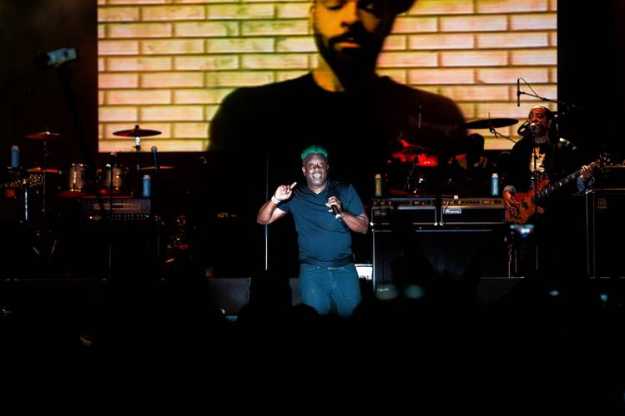| |
Taken from WSJ (Aug 31, 2016)
Genres Without Bias at Afropunk
At the annual festival, funk, punk, hardcore and more celebrated diversity in music.
by Jim Fusilli

Corey Glover, Will Calhoun and Doug Wimbish of Living Colour, performing at the Afropunk Festival.
Photo: Seher Sikandar |
Brooklyn, N.Y.
The legendary funk-and-punk veterans went on near sunset at the annual Afropunk Festival held here this past weekend: On Sunday, members of Bad Brains, Fishbone and Living Colour jammed together; a day earlier, George Clinton and his band explored his Parliament-Funkadelic repertoire. Though there was an abundance of talent elsewhere throughout the impressive two-day event, the presence of these innovators was an acknowledgment of their contribution not just to Afropunk itself but to all contemporary music.
To focus on bands that got their start in the 1970s and ’80s isn’t to suggest a shortage of exceptional newer artists at the festival. They included Angel Haze, Flying Lotus, Kelela, Janelle Monáe, Seinabo Sey, Shabazz Palaces, TV on the Radio and Tyler, the Creator. The lineup also featured punk bands Downtown Boys, In the Whale, Radkey and Trash Talk. Some noteworthy performances avoided the hardcore Afropunk approach. As she did for her June ’16 album “The Dreaming Room,” Laura Mvula nudged aside the gentle chamber pop of her earlier work for a crisp, more assertive sound. Already a stately presence at age 30, she stood at center stage wearing an electronic keytar and sang magnificently with a versatile quintet that featured her brother, James Douglas, on cello. Some 22 hours later, Gallant and his three-piece band performed songs from “Ology,” his April ’16 debut. The long-limbed soul singer prowled the stage as he unleashed his stratospheric falsetto in a set that migrated between slinky and frenzied.
A celebration of African-American music and culture, the Afropunk Festival has its roots in a scene that bubbled up in the late 1970s around punk and hard rock made by black musicians including Bad Brains, a Washington, D.C., group that formed in 1977, and Fishbone, which began working in Los Angeles in 1979. Way back then their choice of expression seemed an act of defiance.
During a phone conversation last week, Fishbone bassist John Norwood Fisher recalled a friend telling him rock was a dead end for a black musician, despite the late-’60s success of Jimi Hendrix and Sly and the Family Stone. But Mr. Fisher said he believed hard-rocking bands led by African-American musicians, like Bad Brains, the BusBoys and Mother’s Finest, were reclaiming the music of Chuck Berry, Fats Domino, Ike Turner and others. By the time the debut album by New York’s Living Colour arrived in ’88, the mainstream seemed ready to welcome hard rock made by African-Americans. Almost 30 years later, the idea of denying talented musicians any opportunity due to their race or gender is ludicrous, laughably so.
During his set, Mr. Clinton and his ensemble dove into the P-Funk catalog, opening with late-’70s and early-’80s tracks “One Nation Under a Groove” and “Atomic Dog” that once seemed an improbable mashup of Frank Zappa and James Brown’s band. Here, as many as six singers delivered the top lines, but these were secondary to the polyrhythms that hit hard on the one and prospered from the fluidity of bassist Lige Curry. When trumpeter Bennie Cowan soloed, the music moved into Miles Davis-inspired jazz-funk.
Following a fierce set by British hard-rock band Skunk Anansie, Living Colour kicked off Sunday evening’s jam with its punk featuring tough unison riffing by guitarist Vernon Reid and bassist Doug Wimbish. Led by the wildly demonstrative singer and saxophonist Angelo Moore, the members of Fishbone joined in for a version of Brown’s “Get Up (I Feel Like Being a) Sex Machine” that rode the two-bass attack by Messrs. Fisher and Wimbish. In its set, Fishbone moved away from punk music to play jubilant funk and ska, but retained a punk attitude as Mr. Moore and trombonist Jay Armant ventured into the audience to body surf. Mr. Clinton, who had been watching from the side of the stage, and Living Colour’s singer Corey Glover, with his cropped, Joker-green hair, took over the vocals for a free-form “Shakey Ground,” a 1975 hit for the Temptations that was co-written by Clinton colleague Eddie Hazel. “Ain’t it a dream come true,” cheered Mr. Moore.
Bad Brains was represented by three of its members—guitarist Dr. Know, bassist Darryl Jenifer and drummer Earl Hudson—who, supported by Fishbone and Living Colour, ripped into its hardcore punk with such intensity that a mosh pit erupted in front of the stage. As they attacked their punk, reggae and rock mix with Mr. Reid and Fishbone’s Rocky George discharging blizzards of notes on their guitars, it became apparent the veterans hadn’t lost any of their bite. If their raging music was a statement about the vitality of hardcore, so too was the onstage sense of community that gave birth to the Afropunk movement and the now-accepted attitude that all rock and pop belongs to everyone.
Mr. Fusilli is the Journal’s rock and pop music critic. Email him at jfusilli@wsj.com and follow him on Twitter @wsjrock.
|
|